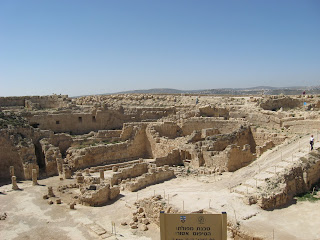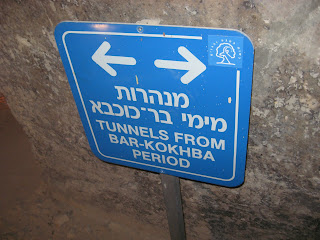We finally got off to Herodion, one of Herrod the Great's most ambitious building projects. It served as his summer palace, fortress, monument, burial ground and district palace when he was the Judean King from 37-4 BCE.
The complex was built in two sections - Upper Herodion, containing the palace set within a circular fortress on an artificial cone-shaped mountain; and Lower Herodion, at the base of the mountain, which had numerous palace annexes for use by family and friends.
Upon Herrod's death, the Palace was bequeathed to his son, Archelaus, who ruled from 4-6 BCE. When Archelaus was banished (he was a bad ruler), Herodion passed to the Romans until it was taken by Jewish rebels during the outbreak of the great revolt against Rome in 66. The zealots lived there for four years until it was retaken by the Romans, but during their stay they built a synagogue and a Mikveh.
The site was abandoned until 132 when Jewish rebels once again occupied the site while fightinign the Bar Kochba revolt.
Herodion was once again abandoned in 135 until the Byzantines took residence between the 5th and 7th centuries.
Josephus Flavius was the ancient historian who described Herodion in great detail.
Upper Herodion was excavated in 1962 and was completed in 1967 under the auspices of Father Vigelio Corbo, a Franciscan of the Custodia di Terra Santa in Jerusalem; Lower Herodion was excavated in 1972 and completed in 1988 by Ehud Nezer for the Hebrew University.
An extensive surprise assault system from the Bar Kochba period was found in the Upper Herodion that included water cisterns and tunnels.
Herodion is surrounded by Arab villages that sharply contract the Israeli "settlements." In the distance we could see mosques with their minarets reaching for the sky.
Some of the structure of the Upper Herodion reminded me of the Cliff Dwellings in Mesa Verde.
The Lower Herodion included a large pool and gardens.
Walking through the extensive tunnels in the Cisterns of the Upper Herodion, it was easy to see how the rebels from the Bar Kochba rebellion could have survived. There were many roomy areas that could have comfortably accommodated them for some time.
As we walked toward the exit we noticed a pile of large rounded stones that were either used in a catapult or a canon to attack the outer walls of the Herodion.







































































No comments:
Post a Comment